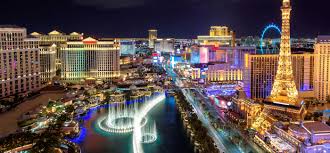Current Trends in Las Vegas Tourism
Tourism in Las Vegas has taken a plunge this summer, as hotels and convention centers report a significant drop in visitors compared to previous years. The city’s allure, known for its extravagant entertainment and gaming options, has seen under 3.1 million tourists arriving in June—a staggering 11 percent decline compared to the same month last year. Officials are pointing fingers at external factors, indicating that decreasing international travel and stringent policies are detrimental to this vibrant tourist hotspot.
Statistics Reflecting the Downturn
Data from the Las Vegas Convention and Visitors Authority indicates that international travelers declined by about 13 percent, while hotel occupancy plunged by roughly 15 percent. Airlines predicated to carry increased numbers of tourists have also felt the impact. Air Canada cited a 33 percent decrease in June traffic, and WestJet observed a 31 percent drop in passengers flying to Harry Reid International Airport. The situation is indicative of a broader trend affecting tourism in various major destinations across the country.
Understanding the Tourism Landscape
The dip in Las Vegas tourism is not an isolated incident; it aligns with national trends observed by travel forecasting companies. Initial projections predicted a robust increase of nearly 9 percent in international arrivals for the year, but this forecast has been adjusted, now anticipating a decline of 9.4 percent. The ripple effects are expected to impact several regions, notably stemming from Canada—previously the largest source of visitors to the United States.
Impact on Local Businesses
Many businesses, particularly those in the hospitality and entertainment sectors, rely heavily on tourist traffic. A decrease in visitors has sent ripples through the economy, affecting restaurants, hotels, and interactive entertainment venues. Reports from travel agents indicate a notable downturn in inquiries and bookings, especially trending toward Las Vegas.
Key Questions Arising
- What changes have businesses observed in visitor patterns? Local actors in tourism are encouraged to gather current data compared against previous years to assess the impact from recent shifts in policies.
- How could shifts in tourism affect local budgets? With a decreasing tax base from tourism, municipalities may need to reevaluate their budgets and plan for changes in expenditure.
- Are seasonal visitors affected? Regions that typically attract visitors from colder climates may notice shifts in snowbird populations, needing to track and adjust marketing strategies accordingly.
The Historical Context of Las Vegas Tourism
Las Vegas’s evolution as a tourism destination began with its initial establishment in the early 1900s. The city gained momentum in the 1940s, driven by defense industries and the construction of the Hoover Dam, which attracted individuals seeking games of chance. Legalized gambling in Nevada in 1931 transformed Las Vegas into a prime entertainment hub. Over the decades, the city has reinvented itself multiple times, shifting its image from a ‘sin city’ to a family-friendly destination featuring lavish hotels and themed resorts.
Previous Resilience in Tourism
Despite facing challenges over the years—from economic recessions to shifts in gambling regulations—Las Vegas managed to rally, introducing fresh attractions and experiences. These adaptations included the development of mega-resorts blending entertainment, lodging, and dining into single luxurious packages. Las Vegas’s appeal lies not merely in gambling, but in offering a full-bodied experience, including shopping and international cuisine, further enhancing its market reach.
Looking Ahead: What Does the Future Hold?
Forecasts suggest that addressing the current downturn will require innovative solutions. The tourism sector will need to pivot and perhaps focus on diversifying the types of experiences offered—not just relying on gambling, but emphasizing adventure-oriented activities, cultural events, and outdoor experiences in the surrounding landscapes like Lake Mead and Red Rock Canyon.
Conclusion
The recent decline in tourism to Las Vegas reflects a complex interplay of global and local factors. As the city braces to meet these challenges, its historical ability to adapt provides a glimmer of hope for revitalizing visitor interest. With its iconic reputation and distinctive attractions, Las Vegas will continue to be a crucial destination in the tourism landscape. For those looking to further explore exciting maritime adventures or rental options, GetBoat.com serves as an invaluable resource for renting boats and yachts that can enhance travel experiences by offering unique perspectives on surrounding waters.


